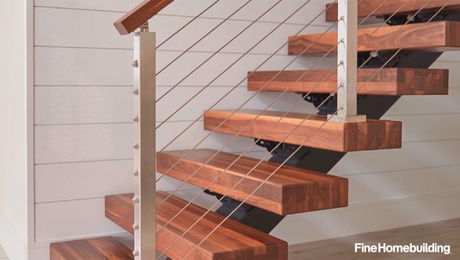Removing a stripped screw. How to do?
Is there a typical method to remove a stripped screw? I assume that I would be drilling into the screw and then inserting something attached to my drill so that I can back out the screw but not sure what to use. Any help?
Regards,
Buzzsaw
“Don’t ask yourself what the world needs. Ask yourself what makes you come alive, and go do that, because what the world needs is people who have come alive.” Gil Bailie


















Replies
There is no typical method as there are no typical stripped screws.
There are a number of technics.
The is a paste with grit in it, don't remember what it is called, that you can put on the screw and that it will sometime allow a screw drivere to bite in enough to unscrew it. I would try an auto parts store.
There are fluted head bits, sorta like a reverse counter sink, that will sometimes work.
You can use a Dremel and get a new slot in the head.
You can use a Dremel to cut off the head and then disasemble the part and use visegrips on the shaft.
You can drill a hole in it and use an extractor, eazyout is one type.
BTW, the last one of those that I had to do the bolt broke off down in the hole, but was not frozen. When I tried to drill the force of the bit cause it to go into the hole. So I had to get a left hand bit.
The force of the bit was enough to spin the stub of the bolt out.
And I am sure that there are a few others that I have forgotten.
Thanks Bill. I think I like the "You can drill a hole in it and use an extractor, eazyout is one type" option. I just have to look up what an extractor (eazyout) is...Regards,
Buzzsaw
"Don't ask yourself what the world needs. Ask yourself what makes you come alive, and go do that, because what the world needs is people who have come alive." Gil Bailie
Don't know if it will apply to your situation, as I don't know what material the screw is in (finished, interior, etc), but one method that works well is to weld a nut or machine screw on top of the stripped screw or bolt head.(more for screw/machinescrew/bolt in metal rather than wood, but i've used before in rough wood)
Edited 9/12/2005 8:30 am ET by ProBozo
View Image
http://www.sears.com/sr/javasr/product.do?BV_UseBVCookie=Yes&vertical=TOOL&pid=00952152000&subcat=Bolt-Out%2C+Taps+%26+Dies
Thanks for this link. I'm wondering if they carry this at the big box stores. I'll have to check it out.Regards,
Buzzsaw
"Don't ask yourself what the world needs. Ask yourself what makes you come alive, and go do that, because what the world needs is people who have come alive." Gil Bailie
The orange big box carries Irwin brand of easy outs. They work -ok- but, the real pain is drilling the starter hole in the broken shaft
g'luck
michael
Thanks Michael,
I went on-line at HD and noticed that they had Irwin. It looks like the Craftsman product should be a good purchase.Regards,
Buzzsaw
"Don't ask yourself what the world needs. Ask yourself what makes you come alive, and go do that, because what the world needs is people who have come alive." Gil Bailie
The only sure-fire way is to burn down the house. The screw can then be easily removed.
Although it may be better to try a few other things first --
-- Make sure that you have a PROPERLY FITTING screwdriver, and one that isn't worn out and rounded over itself. Often this is all that's needed.
-- Try a "impact driver" -- an odd sort of screwdriver that you hit with a hammer to turn. It will will work on about 80% of the "problem" screws, provided you try it before you've totally hosed the screw head.
-- Saw a slot in the head. A Dremmel is good for this.
-- Dig out around the head, if necessary, and grip it with Vice Grips. Sometimes, if it's a round-head screw or it's not all the way in you can do this without the digging.
-- There are several chemicals sold (check your local HW store) that purport to improve the grip of screwdrivers. (I've never tried them.)
I had a neighbor, a slight guy who worked at Army Corps of Engineers, who for years picked up lots of spare money when large auto mechanics were stuck getting a screw of bolt to move that had a stripped head.
He put grinding paste on the head and the small granules in the paste would fill the gaps allowing the screw to be backed out.
Lee Valley has such a paste
Interesting. Thanks for the tip...Regards,
Buzzsaw
"Don't ask yourself what the world needs. Ask yourself what makes you come alive, and go do that, because what the world needs is people who have come alive." Gil Bailie
You can take a center punch and try to drive the head counter clockwise with a hammer, the only common approach that hasn't been mentioned so far.
The best penetrating lubricant for this kind of thing is called SiliKroil, it's from a company called Kano Laboratories, last time I ordered they were at 1000 S. Thompson Lane in Nashville, TN. But that was a few years ago.
A lot depends on how big the screw is, and what it's in. The punch and hammer may work on a 1"-8 better than on a 4-40. On a big one like that, you may be able to find the center and drill out progressively larger until you start breaking thru the root diameter. Carefully file out the rest of the way around to the root diameter, then dig the threads out with the hammer and punch. Very labor intensive, but maybe worth it if you value the item it's stuck in.
Another way to go if there's enough metal around the screw is just to drill it out bigger and shoot a helicoil.
-- J.S.
If you have to you could use a hole saw cutting around the screw remove the wood with the screw and replace with a plug of the same type of wood.
Turtleboy
Buzz, no trick works all the time - and this is no exception- but when it works, it's the fastest and easiest way I've seen. If the exposed shaft will allow, chuck a drill down around the head (or shaft, if it's sheared) and back it off. A keyed chuck works best, and it should be a variable speed drill. Use all three holes in the chuck to get it tight, and start slowly. If you're worried about marring your chuck, well, you should probably be pre drilling these screws anyway.
Yeah, I've used the drill chuck technique a couple of times. Nice thing is that the chuck can get in tight where vice-grips, etc, can't, so it can grab a round-head screw head or some such even when it's near flush.
I just remembered a similar situation, except I was doing everything right - predrilling for a hinge screw in mahogany - the only thing I did wrong was buying one of those chinese sheapy pilot bits, which broke right off way down below the surface. I ended up taking the bits out or a 4 way screwdriver shaft, chucking THAT into the drill, spinning it against a file to sharpen the end, filing a few teeth in the resulting "mini hole saw", and removing a core around the bit. Those "bargain bin" tools are anything but a bargain.
There are a series of "hole saws" made to do that.But I have heard of using steel tubing (brake line) to make your own.Pick a size with an ID just larger than the screw (or bit in your case) and file teeth in the end.
Instead of a drill chuck, try a tap wrench. You'll get more torque on the screw before it slips.
-- J.S.
Cept the tap wrench doesn't come to as much of a point, and its jaws aren't nice and pointy to get a good grip on the head/shaft.
It depends how many different kinds and sizes you have. I have some old ones that grab better in tight places than a chuck.
-- J.S.
As saulgood said, back it out with a chuck, I've only ever done it with a keyless chuck on a cordless.
Your brother down under
I've had very good luck on several occasions using vise grips. Of course there has to be something sticking out to clamp on to, but I have broken loose round head screws and broken bolts etc. without drilling.
Sears makes a special set with three different sized bits that I found to work real good. They have a spade shaped point that you put in your drill...you run the drill in reverse slowly while pushing down on the screw head and it digs into the screw and backs it out. I dont remember what they are called... but they are $20 for the set of three. I have seen them on sale before...I think I got mine for $9.99.
Not mentioned yet is EDM removal. Have used that to successfully remove broken 4-40 and 2-56 taps from aluminum castings. 'course you gotta have an EDM setup.
How does that work? I used to send aluminum electricical panels off machinery to a shop and they EDM burned the screw out without doing anything to the aluminum.
I would think you could do it with some sort of electrolytic setup if you could immerse the entire piece in fluid.